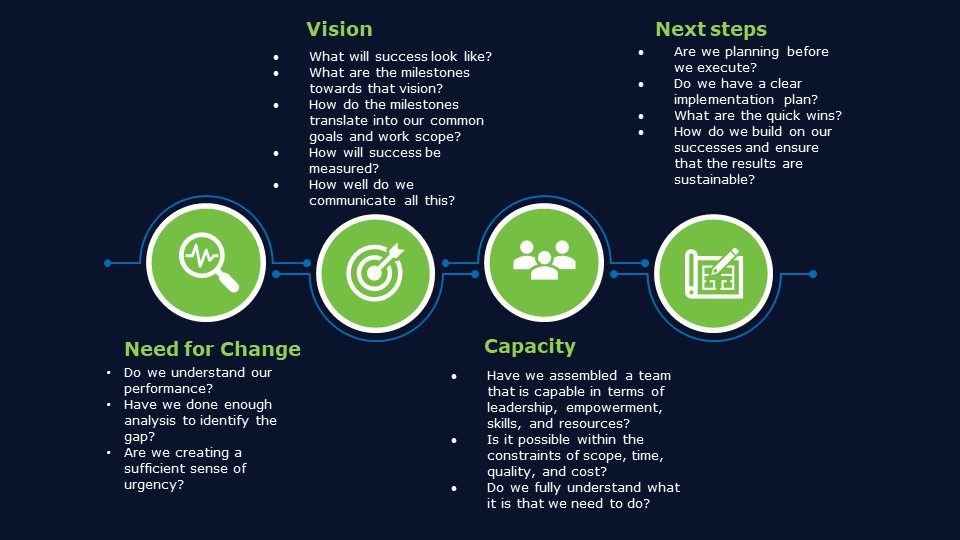At a Glance
- Successful organisational transformation necessitates a significant behavioural change from employees
- Organisations must understand the intricacies of organisational change in order to drive positive behavioural change and improve performance management
- The first step in changing employees’ behaviour and attitudes is to get their buy-in
- Effectively managing the employees’ emotional roller coasters will determine the success of the transformational change
Organisations are under increasing pressure to embrace frequent change, driven by factors such as rapid technological advances, globalisation, and fast-changing customer expectations, according to a study by The Conference Board Study.
Up to 70% of Human Resource (HR) personnel reported that the organisations they represent have experienced organisational change in the past two years, based on a survey carried out by the Society for Human Resource Management (SHRM).
Based on these findings, it is clear that organisations need to cultivate a proactive approach to change management that fosters adaptability and agility in order to thrive in today’s ever-changing business landscape.
This article discusses the often-neglected aspect – how to navigate the challenges of changing employees’ behaviour and mindset to drive a successful organisational transformation.
Change can be challenging
Organisations are expected to adapt to keep pace with the rapidly changing environments. However, this can be a complex process that may evoke a range of responses from employees – both positive and negative.
From introducing a new system, restructuring a business through mergers, acquisitions, or debt restructuring, to implementing sustainability initiatives, changing employees’ behaviour can be challenging.
However, it is important to understand that successful organisational transformation necessitates a significant behavioural change from employees. Recognising the difficulties associated with change is essential. Here are some reasons why implementing change can be challenging:
- It is difficult to overcome ingrained behavioural patterns. It takes between 18 and 254 days to form a new habit, with an average of about 66 days, according to a study in the European Journal of Social Psychology.
- There is a sense of insecurity or anxiety. Change triggers feelings of uncertainty in employees, leading to a sense of apprehension about embracing new practices. Fear of the unknown can hinder employees’ willingness to adopt new organisational changes.
- There is a lack of communication. Poor communication affects the level of trust of 45% of employees within an organisation. Effective communication is essential to help employees understand the changes and how they can contribute to them.
- Cognitive biases reinforce existing behaviours. Employees resist change because of cognitive biases that influence decision-making. There is a 46% correlation between cognitive biases and change acceptance.
Breaking down barriers
Organisations must understand the intricacies of organisational change in order to drive positive behavioural change and improve performance management. It is therefore essential to allocate adequate resources to facilitate successful change. Organisations can only pave the way for meaningful progress and sustainable growth by tackling the barriers that prevent change. Here are some steps to navigate the challenges of changing employees’ behaviour.
Getting Employee Buy-In
The first step in changing employees’ behaviour and attitudes is to get their buy-in. The change formula, coined by David Gleicher in the early 1960s and refined by Kathie Dannemiller in the 1980s, best describes the four essential components of a change effort.
- D (Dissatisfaction). The acknowledgment of the current inadequacies and limitations.
- V (Vision). A clear view of the desired outcomes, detailing achievable targets.
- F (first steps). Identifying concrete actions that can propel the organisation closer to the desired goals.
- R (Resistance, then change). Acknowledging that resistance is part of the natural response to change and taking the necessary steps to tackle it for a successful transformation.
Based on these four aspects of change, here are some considerations:
Implementing Procedural Changes
The procedural environment plays a critical role in setting expectations for the workforce’s behaviours and actions. The process of raising awareness of procedural matters and developing solutions is referred to as the Focus Process®.
Renoir’s Focus Process service is an effective and proven process that empowers employees to take ownership of the project implementation. During this phase, employees can better understand the issues, develop root cause solutions and achieve measurable and lasting change.
Managing Emotional Roller Coasters
When leaders initiate change, there are three possible outcomes that may occur:
- Trial: Some employees embrace the changes positively and actively support the implementation.
- Frustration: In some cases, employees may offer only superficial support, which is a common situation experienced by change champions.
- Denial: Some employees may reject the change outright. In these situations, the employee’s position is clear.
At this stage, effectively managing employees’ emotional roller coasters will determine the success of the transformational change. Here are steps that can be taken to address these challenges:
- Provide education and training. Provide appropriate training and supporting documentation to help employees accept and understand the changes. Consider a staggered rollout to ease the transition for large groups. On-the-job coaching using direct instruction through observation and structured intervention techniques is also an effective strategy.
- Encourage intrinsic motivation. Design the changes in a way that encourages intrinsic motivation among employees. This can be in the form of new job descriptions that are aligned with the changes. Recognise that personal commitment can influence successful implementation during this period.
Make your change a reality
It is easy to criticise the way people work, but it is difficult to change their approach. Similarly, developing innovative ways of working may seem easy, but getting employees to accept and adopt these changes is a daunting task.
Implementing significant change seamlessly is a rare skill that only the experts possess. Renoir has 28 years’ experience of delivering projects through to full adoption using our behavioural and cultural change methodologies. Our change management expertise ensures the new ways of working are rapidly embraced by the organisation and its employees.
Looking for experts to drive a successful organisational transformation?











